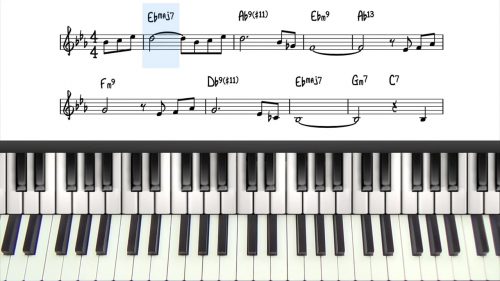Gospel Passing Chords & Substitutions
Welcome to lesson 2 in this masterclass course on the gospel blues.
In the first lesson of this course we explored the basic 1-4-5 progression in the key of F. In this lesson we will broaden the harmony by introducing some alternate chord changes, reharmonisations, and gospel passing chords.
Substituting Chords in 1-4-5 Progressions
The 1-4-5 progression is the ‘skeleton’ of the gospel blues and there are many ways that we can embellish this basic chord progression with reharmonisations and alternate harmonies.
What Are Passing Chords In Gospel Piano?
Passing chords are additional chords that we put into the gospel blues progression to add more harmonic movement and interest. Passing chords are often added before the main chord changes to create a greater sense of tension and resolution in the progression.
Passing chords in gospel music can be seen as ‘temporary stepping stones’ between the core chord changes 1, 4, and 5, and they are used to enhance and decorate the simple 145 gospel blues progression.
In this lesson we cover 4 types of gospel passing chords:
Chromatic Passing Chords
We start with a chromatic walk up to the IV chord. For this gospel walk up we play 2 chromatic passing chords which are both voiced as dominant 7 voicings with the 5th on top:
We voice the Ab7 with the 9th (Bb) to add some colour to the chord, and the A7 is voiced as a basic inverted 7th chord with octave bass. Study the demonstration in the video to understand the left hand accents.
Suspended Passing Chords
Suspensions are very commonly played in gospel music. In the example above, we play a Bb9sus after approaching the IV chord with a chromatic walk up.
Suspended passing chords are particularly effective on the IV chord in the 3rd bar of the form but can be used on any dominant chord to create additional suspense and tension.
Diatonic Passing Chords
We can enhance the basic 1 to 5 movement with a 1625 progression. The 1625 progression uses the diatonic chords from the F Major Scale but with some slight tweaks. The VI chord, D-7 is voiced as a D7 and most often includes chord alterations such as the b9, #9, and #5:
Adding chord alterations to passing chords creates even more tension and a harmonically rich and interesting progression.
This movement can be further enhanced with a chromatic passing chord into D7, which would be an E7 chord. The D7 can also be voices as a D7sus chord as discussed above.
Diminished Passing Chords
Diminished passing chords can be used to achieve smooth, step-wise bass line movement in the gospel blues progression. For example we use a Bdim7 chord in bar 4 to connect Bb7 and the F/C chord in bar 5.
Diminished chord are often used in the turnaround as demonstrated in the lesson, for example: F7, F7/A, Bb, Bbdim7 –> to C7 which creates a step wise bass line leading to the V chord C7 which sets us up for the next chorus.
Lesson Downloads
-
Gospel Passing Chords Transcription File Type: pdf
-
145 Progression Reharmonisations File Type: pdf
-
Passing Chord Examples From Lesson File Type: pdf
Practice Tips
-
Experiment with 'walk up' passing chords in gospel music. These types of passing chords are particularly effective when played before one of the core chord changes which are the I, IV, and V chords.
-
Add the suspended 4th in your dominant chord voicings to create additional suspense and tension which is most often then resolved into the major 3rd for example, Bb9sus to Bb7.
-
Apply suspensions to the IV chord and try to find other opportunities to use this reharmonisation.
-
Copy and emulate the many variations of 1625 embellishments shown in this lesson that can be used to move from the I to the V chords in bars 5 through 7.
-
Remember that tritone substitute passing chords can be used within the 1625 progression such as D7 to Ab7 before landing on the G7 chord.
-
Use the gospel passing chords presented in this lesson for inspiration and listen to gospel piano recordings on YouTube and Spotify for more ideas and insights.








Just can’t contain my happiness watching these lessons! Am over the moon – Thank You so Much!💜 I have so much to learn! Love the Gospel course!
I hear you Tina!!!
Thanks so much Davell. Coming from Scotland to Canada I’ve had little exposure to Gospel music. I’ve already learned a great deal from your first two lessons. I play mostly straight jazz and I’m looking forward to taking my playing to a whole new level.
That makes two Canadians warming us all up!!!
I could listen to this all day!!! Whoo Hoo!!
Thanks so much to Davell for your ultra generous teaching and warm giving spirit!
And Hayden thanks so much for putting it all together like this – it’s so great – all the resources – everything really is fantastic – seeing the hands, pausing, playing back at any time, in any time, reading the notes and tips, the downloads – it’s so so so supercharged – thank you!
M
Thanks Megan – glad to hear you’re enjoying the lessons and I will forward the comments onto Davell.
Hope you are keeping well and talk soon!
Cheers, Hayden
Juicy!
Great lesson and beautifully explained and built on too. It’s a lot of fun to play this stuff and to try and sing at the same time!